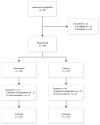A diet, physical activity, and stress reduction intervention in men with rising prostate-specific antigen after treatment for prostate cancer
- PMID: 22018935
- PMCID: PMC3267863
- DOI: 10.1016/j.canep.2011.09.008
A diet, physical activity, and stress reduction intervention in men with rising prostate-specific antigen after treatment for prostate cancer
Abstract
Background: Nearly 35% of men treated for prostate cancer (PrCA) will experience biochemically defined recurrence, noted by a rise in PSA, within 10 years of definitive therapy. Diet, physical activity, and stress reduction may affect tumor promotion and disease progression.
Methods: A randomized trial of an intensive diet, physical activity, and meditation intervention was conducted in men with rising post-treatment PSA after definitive treatment for PrCA. Intention-to-treat methods were used to compare usual care to the intervention in 47 men with complete data. Signal detection methods were used to identify dietary factors associated with PSA change.
Results: The intervention and control groups did not differ statistically on any demographic or disease-related factor. Although the intervention group experienced decreases of 39% in intakes of saturated fatty acid (SFA as percent of total calories) (p<0.0001) and 12% in total energy intake (218 kcal/day, p<0.05)], no difference in PSA change was observed by intervention status. Signal detection methods indicated that in men increasing their consumption of fruit, 56% experienced no rise in PSA (vs. 29% in men who did not increase their fruit intake). Among men who increased fruit and fiber intakes, PSA increased in 83% of participants who also increased saturated fatty acid intake (vs. 44% in participants who decreased or maintained saturated fatty acid intake).
Conclusion: Results are discussed in the context of conventional treatment strategies that were more aggressive when this study was being conducted in the mid-2000s. Positive health changes in a number of lifestyle parameters were observed with the intervention, and both increased fruit and reduced saturated fat intakes were associated with maintaining PSA levels in men with biochemically recurrent disease.
Copyright © 2011 Elsevier Ltd. All rights reserved.
Figures
Similar articles
-
Plasma carotenoids and tocopherols in relation to prostate-specific antigen (PSA) levels among men with biochemical recurrence of prostate cancer.Cancer Epidemiol. 2015 Oct;39(5):752-62. doi: 10.1016/j.canep.2015.06.008. Epub 2015 Jul 9. Cancer Epidemiol. 2015. PMID: 26165176 Free PMC article. Clinical Trial.
-
Can diet in conjunction with stress reduction affect the rate of increase in prostate specific antigen after biochemical recurrence of prostate cancer?J Urol. 2001 Dec;166(6):2202-7. J Urol. 2001. PMID: 11696736 Clinical Trial.
-
Dietary manipulation, ethnicity, and serum PSA levels.Urology. 2003 Oct;62(4):677-82. doi: 10.1016/s0090-4295(03)00576-4. Urology. 2003. PMID: 14550442 Clinical Trial.
-
The dilemma of a rising prostate-specific antigen level after local therapy: what are our options?Semin Oncol. 2013 Jun;40(3):322-36. doi: 10.1053/j.seminoncol.2013.04.011. Semin Oncol. 2013. PMID: 23806497 Review.
-
Prognostic Value of Biochemical Recurrence Following Treatment with Curative Intent for Prostate Cancer: A Systematic Review.Eur Urol. 2019 Jun;75(6):967-987. doi: 10.1016/j.eururo.2018.10.011. Epub 2018 Oct 17. Eur Urol. 2019. PMID: 30342843
Cited by
-
Considering the Role of Stress in Populations of High-Risk, Underserved Community Networks Program Centers.Prog Community Health Partnersh. 2015;9 Suppl(0):71-82. doi: 10.1353/cpr.2015.0028. Prog Community Health Partnersh. 2015. PMID: 26213406 Free PMC article.
-
Do Patients with Prostate Cancer Benefit from Exercise Interventions? A Systematic Review and Meta-Analysis.Int J Environ Res Public Health. 2022 Jan 15;19(2):972. doi: 10.3390/ijerph19020972. Int J Environ Res Public Health. 2022. PMID: 35055794 Free PMC article.
-
Combined Effects of Physical Activity and Diet on Cancer Patients: A Systematic Review and Meta-Analysis.Nutrients. 2024 Jun 2;16(11):1749. doi: 10.3390/nu16111749. Nutrients. 2024. PMID: 38892682 Free PMC article.
-
Dietary Factors and Supplements Influencing Prostate Specific-Antigen (PSA) Concentrations in Men with Prostate Cancer and Increased Cancer Risk: An Evidence Analysis Review Based on Randomized Controlled Trials.Nutrients. 2020 Sep 29;12(10):2985. doi: 10.3390/nu12102985. Nutrients. 2020. PMID: 33003518 Free PMC article. Review.
-
Mindfulness-based stress reduction teachers, practice characteristics, cancer incidence, and health: a nationwide ecological description.BMC Complement Altern Med. 2015 Feb 14;15:24. doi: 10.1186/s12906-015-0545-3. BMC Complement Altern Med. 2015. PMID: 25887555 Free PMC article.
References
-
- Hebert JR, Hurley TG, Olendzki B, Ma Y, Teas J, Hampl JS. Nutritional and socioeconomic factors in relation to prostate cancer mortality: A cross-national study. J Natl Cancer Inst. 1998;90:1637–47. - PubMed
-
- Pienta KJ. Aetiology, epidemiology, and prevention of carcinoma of the prostate. In: Walsh PC, editor. Campbell’s Urology. 7th ed Saunders; Philadelphia: 1998. pp. 2489–96.
-
- Klotz LH. Active surveillance with selective delayed intervention: walking the line between overtreatment for indolent disease and undertreatment for aggressive disease. Can J Urol. 2005;1:53–7. - PubMed
-
- United States Cancer Statistics: 1999-2005 Incidence and Mortality Web-based Report. 2009 US DHHS/CDC/NIH-NCI. (Accessed at www.cdc.gov/cancer/npcr/uscs.)
Publication types
MeSH terms
Substances
Grants and funding
LinkOut - more resources
Full Text Sources
Medical
Research Materials
Miscellaneous



